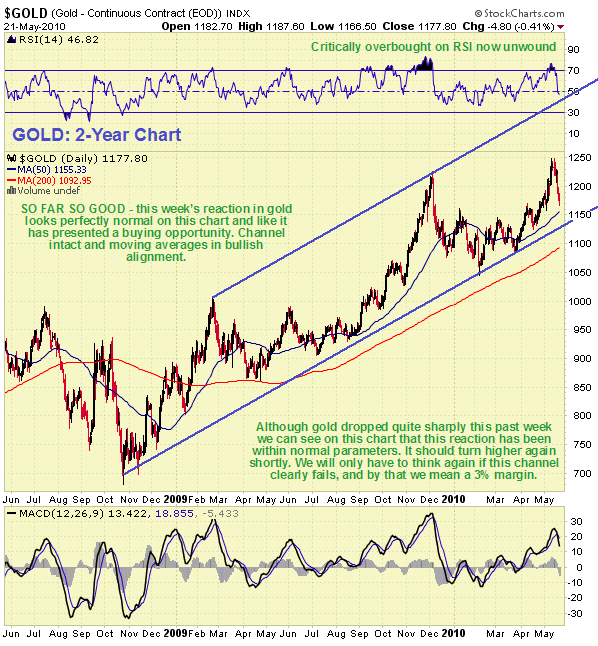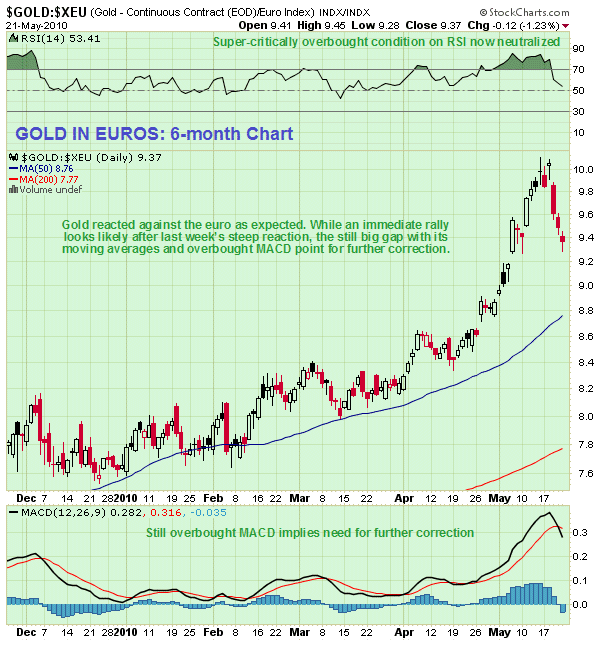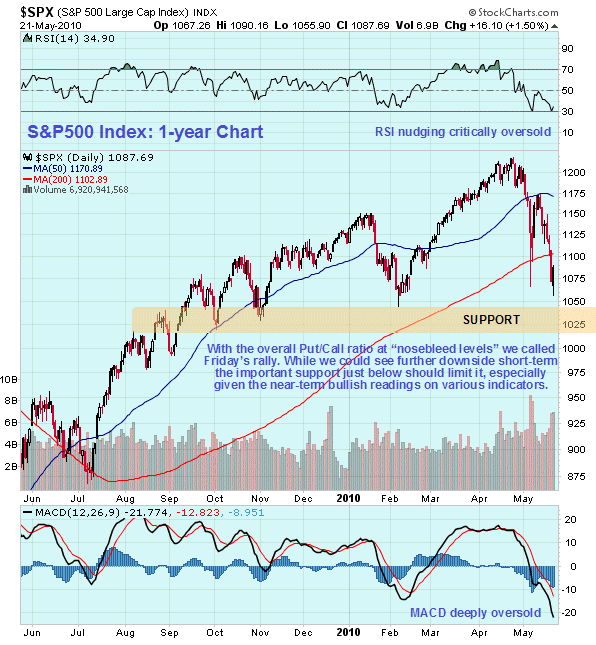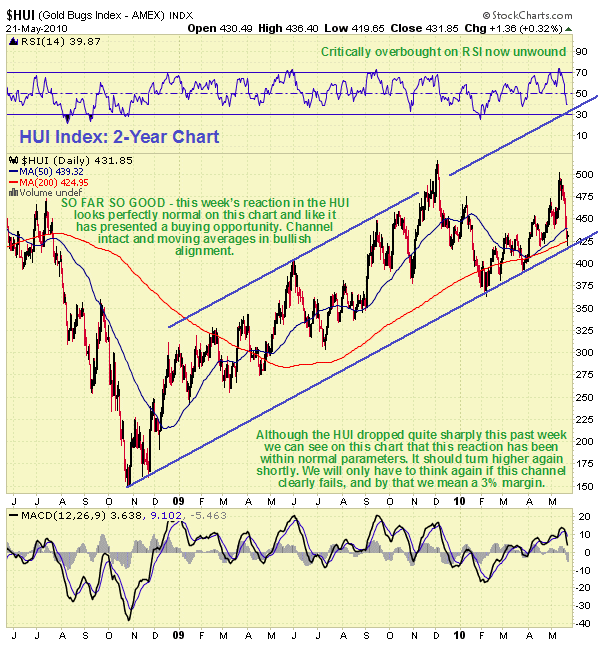Gold Long-term Bull Market Intact, Multiple Factors Support a Rally Now
Commodities / Gold and Silver 2010 May 24, 2010 - 01:12 AM GMTBy: Clive_Maund
 Although gold and silver dropped quite sharply last week, longer-term charts reveal that nothing broke technically and the reactions were in fact within normal parameters.
Although gold and silver dropped quite sharply last week, longer-term charts reveal that nothing broke technically and the reactions were in fact within normal parameters.
On its 2-year chart we can see that the fine longer-term uptrend in gold from late 2008 remains in force, and that despite last week’s drop, it is still some distance from breaking down. In recent weeks it had shown signs that it would not drop with the broad stockmarket, so while the fact that it did may be rather disappointing, the flip side is that with the broad market horribly oversold and due a rally gold looks set to bounce back strongly from here.
Factors which support a rally now, in addition to the nearby trendline support, are the moving averages, which are in strongly bullish alignment, the proximity of the price with the 50-day moving average and the neutralization of the RSI indicator shown at the top of the chart, which had been showing a short-term critically overbought condition.

Gold’s strong rally against the Euro burned out last week, as predicted on the site last Monday, but it dropped so much last week that we are likely to see it recover somewhat this coming week.

As the Precious Metals sector decided to move in step with the broad stockmarket last week, it is worth taking a sideways glance at it to assess the intermediate outlook, as it will obviously impact the outlook for the PM sector going forward. As we had correctly deduced in advance from the insanely extreme Put/Call ratio for the overall US market late last week, it was due to rebound, and did so on Friday. With many other indicators now near-term bullish, although by no means all, we can expect some choppy action in coming days that is expected to be followed by a recovery back to the vicinity of the 50-day moving average on the S&P500 index, which is currently at about 1170.
It is interesting to observe on our 6-month chart for the S&P500 index how it bounced back on Friday from the vicinity of the intraday panic lows of the plunge day early in May, which was misleadingly described as a technical glitch by the mainstream media in order to sooth rattled investors, but was of course the result of blind panic. This action and the big down days of last week have longer-term bearish implications, so after a probable rally back up to the vicinity of the 50-day moving average, the market is expected to go into decline again, although we should keep in mind that nominal losses may be greatly reduced and even conceivably reversed by conditions of increasing inflation and repeated injections of liquidity.

Although Precious Metals stocks were hit hard last week by the combination of the broad market decline and the drop in the metals, their uptrend in force from late 2008 did not fail, and with big support coming into play here from the lower trend channel line shown on the 2-year chart for the HUI index and from nearby bullishly aligned moving averages, stocks are expected to turn sharply higher in tune with a general rebound soon. Here we should note that even if the channel fails, it may only result in stocks going into a sideways trading range for a while, with support coming into play at the bottom of it in the 370 area.

The dollar, which has been feasting on the euro’s misfortunes, has been able to lord it as “King of Hell”, in the recent past. The “world’s reserve currency” which is ultimately reserved for those who want to go broke, has also benefited as a vehicle to be used to make panic buying of Treasuries, which are bought presumably because the buyers can’t think of somewhere better to put their money, and because they seem to be unaware that buying the government paper of a country that is bankrupt is not a particularly smart thing to do. The dollar index is starting to look tired here, and will be very vulnerable to the downside once the euro crisis eases back from the acute stage. US investors should take advantage of this temporary dollar strength to divest out of dollar denominated investments. The underlying fundamentals for the dollar are horrendous. The US government and Fed are now cut off, as if in a pit, having set in motion an unstoppable train of events that will end in hyperinflationary depression, with the point of no return having been passed some time ago.
This hyperinflation will result in the purchasing power of cash dropping by at least 95% and more probably 99%, and ending with the currency becoming totally worthless over a frighteningly short time horizon. Debts and obligations are now so monumental that there is no way they can be honored - there are only 2 choices, default which will lead to instant crisis and ruin, and hyperinflation, which leads to ruin - they can be expected to take the latter option as it buys them some more time. US citizens and investors must take appropriate action to protect their interests with the minimum of delay. When will this hyperinflation hit? This is the big question and it is hard to be precise regarding timing. Inflation is likely to build later this year and we could start to move towards hyperinflation perhaps over a 2 to 3-year timeframe. We will be looking at down-to-earth practical steps that US citizens can take to protect themselves from this looming catastrophe on the site soon.

By Clive Maund
CliveMaund.com
For billing & subscription questions: subscriptions@clivemaund.com
© 2010 Clive Maund - The above represents the opinion and analysis of Mr. Maund, based on data available to him, at the time of writing. Mr. Maunds opinions are his own, and are not a recommendation or an offer to buy or sell securities. No responsibility can be accepted for losses that may result as a consequence of trading on the basis of this analysis.
Mr. Maund is an independent analyst who receives no compensation of any kind from any groups, individuals or corporations mentioned in his reports. As trading and investing in any financial markets may involve serious risk of loss, Mr. Maund recommends that you consult with a qualified investment advisor, one licensed by appropriate regulatory agencies in your legal jurisdiction and do your own due diligence and research when making any kind of a transaction with financial ramifications.
Clive Maund Archive |
© 2005-2022 http://www.MarketOracle.co.uk - The Market Oracle is a FREE Daily Financial Markets Analysis & Forecasting online publication.



